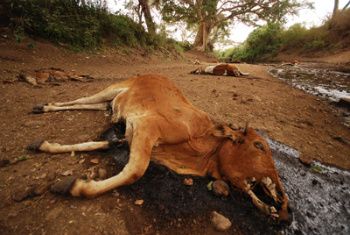Kenya: ‘We see a very, very bad scenario in the next six months if no rains come down’
By Jeremy Hance Kenya was once considered one of Sub-Saharan Africa’s success stories: the country possessed a relatively stable government, a good economy, a thriving tourist industry due to a beautiful landscape and abundant wildlife. But violent protests following a disputed election in 2007 hurt the country’s reputation, and then—even worse—drought and famine struck the country this year. The government response has been lackluster, the international community has been distracted by the economic crisis, and suddenly Kenya seems no longer to be the light of East Africa, but a warning to the world about the perils of ignoring climate change, government corruption, and the global food and water shortages. Children are starving, cattle are dropping dead, crops are withered, lakes are empty, and still the rains haven’t come. Kenya is on the verge of a catastrophe of Biblical proportions. Estimates put the number of hungry around 3.8 million—one in ten Kenyans, so far. However the Minister of Environment said that the number is more likely over 10 million. It is the worst drought since 2000. Food yields for the nation have dropped by over a quarter, while food prices have gone up a staggering 130 percent. This at a time when UN World Food Program (WFP) has announced that food aid has hit a 20 year low and it needs billions more to feed the world’s hungry. “The many less ‘mechanised’ local farmers, herdsmen and fishermen with no means to compete are the ones that suffer. They are among the 17 million in eastern Africa that according to the World Food Programme now depend on food aid for their survival,” said Oliver Nasirwa of Wetlands International—Kenya. No longer able to feed their families, subsistence farmers are dropping their tools, demolishing their homes, and heading towards towns and cities to settle in already overcrowded slums. “In this village, about 50 percent of people have moved to the slum areas. This is going to increase pressure in town,” said Steven Waweru told the AFP in August, an official with Caritas that helps distribute WFP aid in the region. “We’ve not seen that for a long long time”. Waweru says that he has seen a rise in child prostitution and labor due to the exodus of farmers. He expects crime to rise as well. “We see a very, very bad scenario in the next six months if no rains come down,” he concluded. … “The livestock still hasn’t recovered from the 2005 drought. And already we have to confront a new drought. The drought cycle is getting shorter and shorter – every three or four years instead of every 10,” a district veterinary official told AFP in August. …
Kenya’s pain: famine, drought, government ambivalence cripples once stable nation
